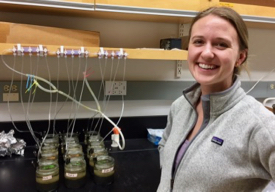Rob Hale, a professor at the Virginia Institute of Marine Science (VIMS), has been studying plastics since the 1990’s. His research in the past showed substantial levels of flame retardants, which are often added to plastics to reduce flammability, in wastewater, sewage, soils, sediments, dust, and in organisms. His findings led to worldwide limitations on these retardants, as they accumulate in the food chain and can end up affecting humans too.
Now, Hale’s team is looking into the effects of microplastics in the ocean. The group received grants from NOAA’s Marine Debris Program in 2013 to investigate how four different types of plastics and their additives are affected by environmental conditions. Hale notes that it is technically difficult to ascertain which compounds are in each plastic and which additives were used, as there are thousands of different combinations.

“Meredith Evans with the treatments she used to test the effects of various types of plastics on microbial communities in sediments.” Source
Meredith Evans, a doctoral student in Hale’s lab, has looked at how different plastics affect the microbial community of the Chesapeake Bay. She found that some plastics could significantly reduce populations of microbes, with potentially major effects on microbial nutrient processing.
Last month, Evans headed to Alaska with W&M Professor Patty Zwollo to study plastic pollution in a place with no other pollutants, helping them isolate the effects of plastics.
Meanwhile, Hale’s team is also teaming up with the Georgia Aquarium in Atlanta to study microplastics in whale sharks. This will require them to study the sharks’ feces to see how much plastic ends up in the sharks.
You can read more about the work of Hale’s team here.
